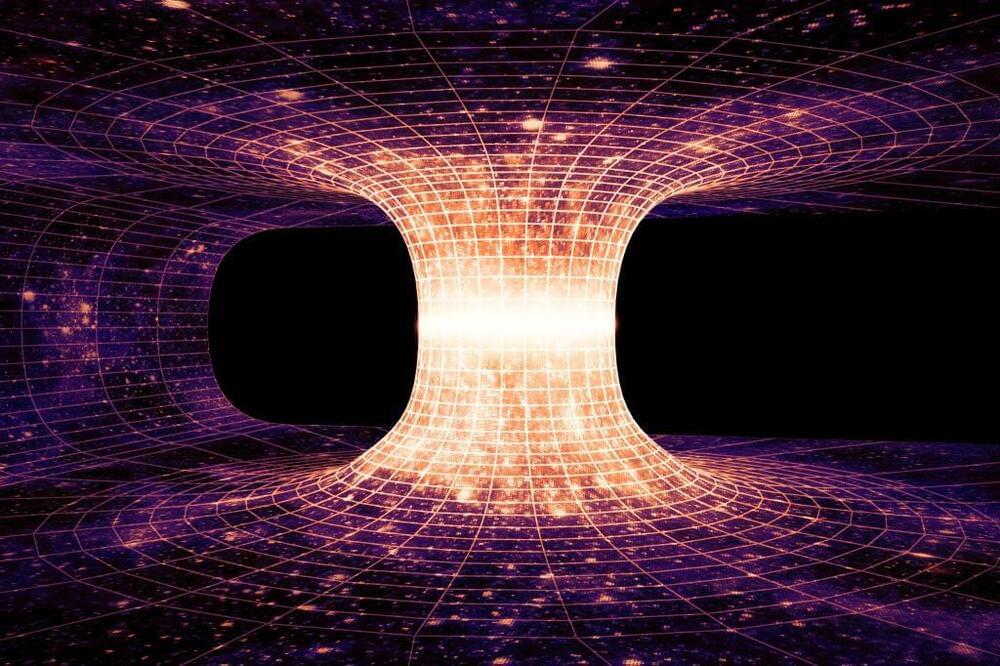The puzzling behavior of black hole interiors has led researchers to propose a new physical law: the second law of quantum complexity.



A groundbreaking revelation has the scientific community buzzing: a possible encounter with a parallel universe. Researchers suggest that signs from the universe’s furthest reaches may indicate another vastly different universe has touched ours, potentially disrupting our universe’s fabric. This interpretation could validate the multiverse theory.
Researcher Dr. Ranga-Ram Chary examined the cosmic microwave background’s noise and residual signals — the remnants of the Big Bang. He discovered several sporadic bright spots, which he speculates could be the echo of our universe colliding with another billions of years ago.
This interpretation is tentative, but aligns with some cosmological theories suggesting that interactions between alternative universes could occur. These theories propose our universe is merely one bubble among countless others. Once a universe initiates in a Big Bang-like event, it perpetually expands. This rule applies to all universes, implying periodic intersections could occur.
Original paper is at https://arxiv.org/pdf/1809.09615.pdf

Euclid is ESA’s mission to shed light on dark matter and dark energy, but teams at the Agency’s mission control centre in Darmstadt, Germany, are also in the dark. A series of problems have befallen the mission in pre-launch simulations.
Currently about halfway through the Euclid simulations campaign, the key focus in the Main Control Room is the Launch and Early Orbit Phase (LEOP) and spacecraft commissioning.
These are the two most critical moments in a mission’s life; as it wakes up after the rigours of launch, makes its first manoeuvres towards its target destination and as its instruments are commissioned.

Even space and time if it’s quantum.
What will be the ultimate fate of our universe? There are a number of theories and possibilities, but at present the most likely scenario seems to be that the universe will continue to expand, most mass will eventually find its way into a black hole, and those black holes will slowly evaporate into Hawking Radiation, resulting in what is called the “heat death” of the universe. Don’t worry, this will likely take 1.7×10106 years, so we got some time.
But what about objects, like stellar remnants, that are not black holes? Will the ultimate fate of the universe still contain some neutron stars and cold white dwarfs that managed to never get sucked up by a black hole? To answer this question we have to back up a bit and talk about Hawking Radiation.
Stephen Hawking famously proposed this idea in 1975 – he was asked if black holes have a temperature, and that sent him down another type of hole until Hawking Radiation popped out as the answer. But what is Hawking Radiation? The conventional answer is that the vacuum of space isn’t really nothing, it still contains the quantum fields that make up spacetime. Those quantum field do not have to have zero energy, and so occasionally virtual particles will pop into existence, always in pairs with opposite properties (like opposite charge and spin), and then they join back together, cancelling each other out. But at the event horizon of black holes, the distance at which light can just barely escape the black hole’s gravity, a virtual pair might occur where one particle gets sucked into the black hole and the other escapes. The escaping particle is Hawking Radiation. It carries away a little mass from the black hole, causing it to glow slightly and evaporate very slowly.

An international team of astrophysicists has discovered hundreds of mysterious structures in the centre of the Milky Way.
The one-dimensional cosmic threads are made up of hundreds of horizontal or radial filaments, slender, elongated bodies of luminous gas that potentially originated a few million years ago — and seem to be pointing the direction of the black hole.
“I was actually stunned when I saw these. We had to do a lot of work to establish that we weren’t fooling ourselves,” added Yusef-Zadeh, who’s also a member of the Center for Interdisciplinary Exploration and Research in Astrophysics.
Joscha Bach is a cognitive scientist focusing on cognitive architectures, consciousness, models of mental representation, emotion, motivation and sociality.
Patreon: https://patreon.com/curtjaimungal.
Crypto: https://tinyurl.com/cryptoTOE
PayPal: https://tinyurl.com/paypalTOE
Twitter: https://twitter.com/TOEwithCurt.
Discord Invite: https://discord.com/invite/kBcnfNVwqs.
iTunes: https://podcasts.apple.com/ca/podcast/better-left-unsaid-wit…1521758802
Pandora: https://pdora.co/33b9lfP
Spotify: https://open.spotify.com/show/4gL14b92xAErofYQA7bU4e.
Subreddit r/TheoriesOfEverything: https://reddit.com/r/theoriesofeverything.
Merch: https://tinyurl.com/TOEmerch.
0:00:00 Introduction.
0:00:17 Bach’s work ethic / daily routine.
0:01:35 What is your definition of truth?
0:04:41 Nature’s substratum is a “quantum graph”?
0:06:25 Mathematics as the descriptor of all language.
0:13:52 Why is constructivist mathematics “real”? What’s the definition of “real”?
0:17:06 What does it mean to “exist”? Does “pi” exist?
0:20:14 The mystery of something vs. nothing. Existence is the default.
0:21:11 Bach’s model vs. the multiverse.
0:26:51 Is the universe deterministic.
0:28:23 What determines the initial conditions, as well as the rules?
0:30:55 What is time? Is time fundamental?
0:34:21 What’s the optimal algorithm for finding truth?
0:40:40 Are the fundamental laws of physics ultimately “simple”?
0:50:17 The relationship between art and the artist’s cost function.
0:54:02 Ideas are stories, being directed by intuitions.
0:58:00 Society has a minimal role in training your intuitions.
0:59:24 Why does art benefit from a repressive government?
1:04:01 A market case for civil rights.
1:06:40 Fascism vs communism.
1:10:50 Bach’s “control / attention / reflective recall” model.
1:13:32 What’s more fundamental… Consciousness or attention?
1:16:02 The Chinese Room Experiment.
1:25:22 Is understanding predicated on consciousness?
1:26:22 Integrated Information Theory of consciousness (IIT)
1:30:15 Donald Hoffman’s theory of consciousness.
1:32:40 Douglas Hofstadter’s “strange loop” theory of consciousness.
1:34:10 Holonomic Brain theory of consciousness.
1:34:42 Daniel Dennett’s theory of consciousness.
1:36:57 Sensorimotor theory of consciousness (embodied cognition)
1:44:39 What is intelligence?
1:45:08 Intelligence vs. consciousness.
1:46:36 Where does Free Will come into play, in Bach’s model?
1:48:46 The opposite of free will can lead to, or feel like, addiction.
1:51:48 Changing your identity to effectively live forever.
1:59:13 Depersonalization disorder as a result of conceiving of your “self” as illusory.
2:02:25 Dealing with a fear of loss of control.
2:05:00 What about heart and conscience?
2:07:28 How to test / falsify Bach’s model of consciousness.
2:13:46 How has Bach’s model changed in the past few years?
2:14:41 Why Bach doesn’t practice Lucid Dreaming anymore.
2:15:33 Dreams and GAN’s (a machine learning framework)
2:18:08 If dreams are for helping us learn, why don’t we consciously remember our dreams.
2:19:58 Are dreams “real”? Is all of reality a dream?
2:20:39 How do you practically change your experience to be most positive / helpful?
2:23:56 What’s more important than survival? What’s worth dying for?
2:28:27 Bach’s identity.
2:29:44 Is there anything objectively wrong with hating humanity?
2:30:31 Practical Platonism.
2:33:00 What “God” is.
2:36:24 Gods are as real as you, Bach claims.
2:37:44 What “prayer” is, and why it works.
2:41:06 Our society has lost its future and thus our culture.
2:43:24 What does Bach disagree with Jordan Peterson about?
2:47:16 The millennials are the first generation that’s authoritarian since WW2
2:48:31 Bach’s views on the “social justice” movement.
2:51:29 Universal Basic Income as an answer to social inequality, or General Artificial Intelligence?
2:57:39 Nested hierarchy of “I“s (the conflicts within ourselves)
2:59:22 In the USA, innovation is “cheating” (for the most part)
3:02:27 Activists are usually operating on false information.
3:03:04 Bach’s Marxist roots and lessons to his former self.
3:08:45 BONUS BIT: On societies problems.
Subscribe if you want more conversations on Theories of Everything, Consciousness, Free Will, God, and the mathematics / physics of each.
I’m producing an imminent documentary Better Left Unsaid http://betterleftunsaidfilm.com on the topic of “when does the left go too far?” Visit that site if you’d like to contribute to getting the film distributed (in 2020) and seeing more conversations like this.
Some of the most violent cosmic collisions occur silently in the vacuum of space, but with the right instrumental ears, we can still hear it happen. Here’s how.
A recently discovered formation of galaxies spanning 3.3 billion light-years is one of the largest known structures in the universe, contradicting some of the most fundamental beliefs of astronomers about the cosmos. The Giant Arc is composed of galaxies, galaxy clusters, and a significant amount of gas and dust. It is located 9.2 billion light-years away and covers approximately one-fifteenth of the visible universe.
The discovery was “fortuitous,” according to Alexia Lopez, a doctoral candidate in cosmology at the University of Central Lancashire (UCLan) in the United Kingdom. Lopez was creating maps of the night sky using light from around 120,000 quasars, which are the bright centres of galaxies where supermassive black holes consume matter and generate energy.
By measuring magnesium’s imprints, Lopez could calculate the distance to the intervening gas and dust, as well as the composition of the substance. The quasars were used as “spotlights in a dark room,” illuminating the intervening matter, according to Lopez. A structure began to emerge in the middle of the cosmic maps, a massive arc that was an indication of the Giant Arc.
If I were a brilliant physicist, I would have written this.
Learn more about differential equations (and many other topics in maths and science) on Brilliant using the link https://brilliant.org/sabine. You can get started for free, and the first 200 will get 20% off the annual premium subscription.
Do humans have free will or to the laws of physics imply that such a concept is not much more than a fairy tale? Do we make decisions? Did the big bang start a chain reaction of cause and effects leading to the creation of this video? That’s what we’ll talk about today.
💌 Support us on Donatebox ➜ https://donorbox.org/swtg.
👉 Transcript and References on Patreon ➜ https://www.patreon.com/Sabine.
📩 Sign up for my weekly science newsletter. It’s free! ➜ https://sabinehossenfelder.com/newsletter/
🔗 Join this channel to get access to perks ➜
https://www.youtube.com/channel/UC1yNl2E66ZzKApQdRuTQ4tw/join.
🖼️ On instagram ➜ https://www.instagram.com/sciencewtg/
00:00 Intro.

The quantum fluctuations that pervade empty space spontaneously give birth to pairs of particles and antiparticles. Ordinarily, these pairs annihilate so promptly that their existence is virtual. But a powerful field can pull a pair’s members apart for long enough that their existence becomes real. In 1951 Julian Schwinger calculated how strong an electric field needs to be to beget electron–positron pairs. Now Michael Wondrak and his colleagues of Radboud University in the Netherlands have proposed that particle pairs can be brought into existence by the immense gravitational tidal forces around a black hole [1].
Wondrak and his colleagues considered all the paths a pair of virtual particles could take during their brief existence. If the vacuum is stable, all pairs that are created are also destroyed. But a strong field destabilizes the vacuum, makes some paths more likely than others, and leads to a deficit of pairs that recombine. The deficit is balanced by a net outflow of real particles, which, in the case of a black hole’s gravitational field, leads to the black hole’s eventual evaporation.
The theorists’ approach is sufficiently general that it could reproduce not only Schwinger’s effect but also Stephen Hawking’s 1974 proposal that if a particle–antiparticle pair springs into virtual existence near a black hole’s event horizon, one member could fall in while the other escapes. What’s more, the researchers found that Hawking’s effect is a special case of a more general phenomenon. Pulling virtual particles into existence depends only on the stretching of spacetime wrought by a curved gravitational field and does not require an event horizon as Hawking originally suggested. One intriguing implication is that a neutron star, whose Schwarzschild radius lies beneath the stellar surface, can also beget particle pairs and decay.